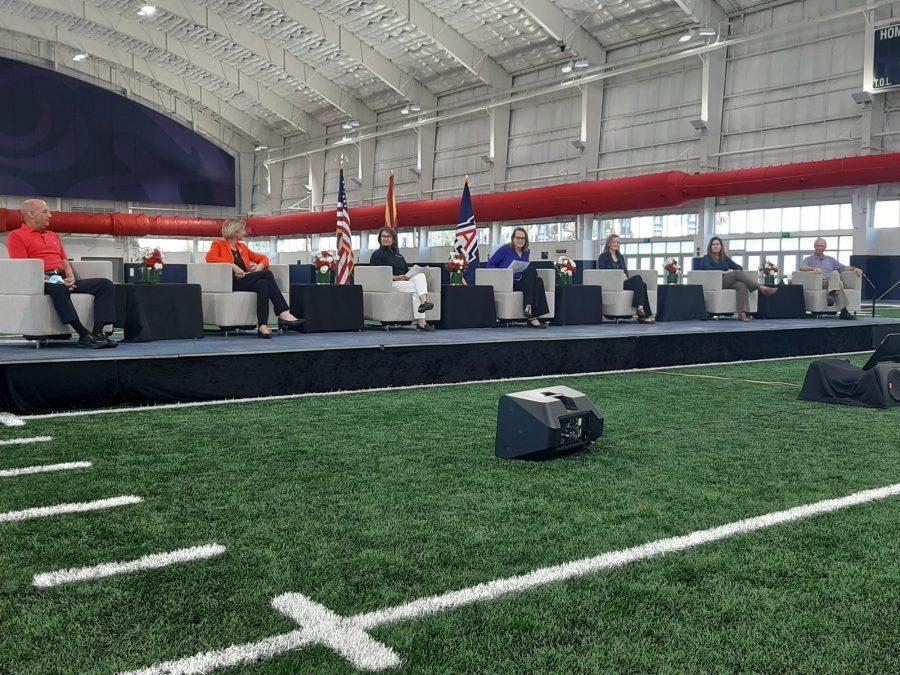Members of the University of Arizona Reentry Task Force met at a press conference Wednesday, May 27 to discuss the strategies they plan to employ in monitoring and lessening the spread of COVID-19 should in-person classes start up again this fall.
UA President Dr. Robert C. Robbins said while administration intends to open campus up again in fall, it’s “not decided yet.”
“We don’t have all the answers right now,” Robbins said. “We will be very purposeful, very thoughtful, … meticulous as we work for … a final answer of a go/no-go about reentering the campus and bringing people back.”
Robbins said he hopes to have that final answer within the next two months.
RELATED: New task force created to prepare for fall semester
With the current intention of welcoming back students for the fall semester, members of the Reentry Task Force spoke about their positions on the force and ways the UA will address COVID-19 on campus.
The speakers at the briefing were Dr. Richard Carmona, former U.S. surgeon general and the director of the task force, Provost Dr. Liesl Folks, Dr. Cecilia Rosales, Kacey Ernst, Katherine Ellingson, Joyce Schroeder and Robbins.
Each speaker addressed a different aspect of campus reentry, providing more detail for the university’s “Test, Trace and Treat” plan of action.
Rosales, the interim associate dean of the Mel and Enid Zuckerman College of Public Health, said they would be implementing a “Test All, Test Smart” program, which would involve utilizing the current COVID-19 tests throughout the UA population.
She said the plan means to assume COVID-19 will be among the population until a vaccine is created and will then help determine how many people have the antibodies for the virus and potentially if herd immunity had been achieved. Rosales also said the plan’s success rested on keeping students practicing proper social distancing.
The plan to maintain student engagement included proposals such as student testing networks, course credit and campus testing trials.
“We also commit to developing a clear communication strategy and plan to maintain communications with key stakeholders, both internally and externally, at the University of Arizona,” Rosales said.
Ernst, an epidemiologist and associate professor with the College of Public Health, introduced two ways the UA planned to address health concerns due to the coronavirus.
Ernst said they planned to use the Wildcat Wellness Checks, a text-based platform allowing students to update campus medical professionals on a daily basis, to identify illnesses, direct students to proper testing facilities or address mental health concerns.
“The individuals who are currently suffering from the COVID-19 disease as well as those who have lost family members or friends — I think it’s really important to acknowledge that people are going to come into this and potentially come onto our campus in varying degrees of both physical health as well as mental health,” Ernst said.
Ernst also spoke about a new tracing method the UA plans to employ. While they do still plan to do some manual tracing, determining which people someone who has tested positive has interacted with, they also are looking to use app-based tracing.
“This mobile app would anonymously exchange codes with other cell phones through Bluetooth,” Ernst said. “The signal strength and duration are recorded. Then when someone has a confirmed positive case of COVID-19, they and their provider receive codes that they can enter into the application. Then a notification is immediately sent to all the phones that they were in close proximity to each other.”
Schroeder, the department head of molecular and cellular biology, clarified that this application would be completely anonymous and voluntary.
“Each individual has total control over the use of this,” Schroeder said.
RELATED: Working a reopening on Main Gate Square
Schroeder also addressed the question of why in-person instruction would be possible in the fall when it wasn’t possible in the spring. She said at the time the university did not have the ability to test for the virus, trace those who had engaged with someone with the virus and isolate those people.
“We have so much greater capacity to test now, to trace now, and over the summer we’re building up our capacity to trace to really historic levels,” Schroeder said.
Ellingson, an associate professor in epidemiology and biostatistics, said the task force would be collaborating with public health partners in Arizona to protect UA faculty, staff and students as well as Tucson from the spread of the virus.
She said the core reentry plan involves several factors: equal outcomes for those returning to campus and those who are not, dealing with COVID-19 cases quickly, providing on- and off-campus isolation options and support services, protecting those at higher risk of serious complications due to COVID-19 and engaging in “transparent and participatory decision-making” as the plan is built.
Folks listed various other ways the university would work to minimize risks, including having flexible learning methods, mandating the use of masks when indoors and lowering the housing capacity in dorms. However, Folks said at this point the UA can likely accommodate every person wanting to live in a residence hall even with the new precautions.
“We are very much working towards a safer operating modality in all of our dorms so that our students can have that rich campus experience if at all possible,” Folks said.
The members of the task force also addressed concerns that young people will not properly engage in social distancing, an issue that became apparent after the reopening of restaurants and bars at Main Gate Square.
“We acknowledge that one of the reasons students want to get back to campus is to reengage in social life,” Ellingson said. She said the task force is working with experts in marketing and psychology to create messages and inform students about “social distancing and protecting each other.”
To watch the full press release, visit the UA’s YouTube channel.
Follow Sam Burdette on Twitter









